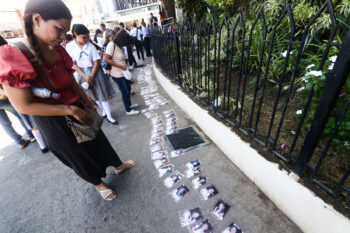GENERAL SANTOS CITY (MindaNews/31 August) — “It’s the same Philippine government but in the Duterte administration’s peace process, it’s “GPH” with the Bangsamoro and “GRP” with the National Democratic Front (NDF)”. This was the lead of a MindaNews report by editor Carolyn O. Arguillas on August 29.
She mentioned that President Benigno Simeon C. Aquino III by Administrative Order No. 5 in 2010 directed government offices in 2010 to use GPH (Government of the Philippines) instead of GRP (Government of the Republic of the Philippines) in their official communications in accordance with ISO 3166-1 Code.
Quoted below is the pertinent portion of AO No. 5, s. 2010 issued on December 9, 2010:
“WHEREAS, the use of initials RP in referring to the Philippines is not in accordance with the ISO 3166-1, leading to ambiguity and confusion;
“WHEREAS, such ambiguity and confusion when referring to the Philippines by the use of initials can be avoided by following the codes assigned to the Philippines by ISO;
“NOW, THEREFORE, I, BENIGNO S. AQUINO III, President of the Philippines, by virtue of the powers vested in me by the Constitution, do hereby direct all offices, agencies and other instrumentalities of the Philippine Government to adopt and use, as soon as practicable, the ISO two-letter code PH or three-letter code PHL [in] referring to the Philippines.” (Bold supplied)
Has the AO been adopted and used as directed?
We are not in the position to assess. But this fact is well known: All agreements and other documents signed by Government and MILF (Moro Islamic Liberation Front) from 1997 under President Fidel V. Ramos to June 2010 under President Gloria Macapagal-Arroyo were referred to as “GRP-MILF”; those under the Aquino and the two-month Duterte administrations were referred to as “GPH-MILF”.
Arguillas wrote that the June 25, 2016 joint statement of the Government and the NDFP (National Democratic Front of the Philippines) in Oslo, Norway was referred to as “GPH-NDFP” but those signed last August 22 to 26 were “GRP-NDFP”. OPAPP Secretary Jesus Dureza explained that all agreements and documents signed before June 25, 2016 were referred to as “GRP-NDFP”, hence, the agreed reference.
We agree with Arguillas that the use of “GPH” with “MILF” and “GRP” with “NDFP” can be a source of confusion. To resolve this, use the correct reference. What must it be? Aquino III erred in his AO No. 5, s. 2010.
The critical questions:
First: Can the President amend the Constitution with an AO?
Second: Can an ISO code supplant legal and official forms and practices used in the administrative operations and political functions of government?
“Republic of the Philippines” is the name of the Philippines under the Constitution. The 1972 and 1987 constitutions were both entitled “The Constitution of the Republic of the Philippines”. The 1935 constitution, originally drafted for the Commonwealth of the Philipines, was just “The Constitution of the Philippines”. However, On July 3, 1946, three days before the grant of independence, the seal or coat of arms of the Philippines officially inscribed with “Republika ng Pilipinas” was adopted.
AO No. 5, s. 2010 amended the constitution by deleting “Republic”. Has the President the power to do this? Only the Congress – not the President — has this power as provided in Article XVI, Section 2 of the 1987 Constitution. By this power, the Congress, in 1998, removed from the seal of 1946 two vestiges of colonialism – the bald eagle symbolizing America and the sea lion symbolizing Spain.
Since July 4, 1946, official acts, letters and documents of government offices have been done under “Republic of the Philippines” and the official seal affixed if necessary – for example, the decisions of the Supreme Court and the lower courts (not just under “The Philippines”); the acts of Congress entitled “Republic Acts” (“RA”, not “PHA”); the official communications of the executive departments and the local governments.
The case in point: Like all other administrative orders, presidential proclamations and executive orders, AO No. 5, s. 2010 closed as usual, “IN WITNESS WHEREOF, I have hereunto set my hand and caused the seal of the Republic of the Philippines to be affixed” – not just “the seal of the Philippines”. An order to drop “Republic” would not have been valid without the “seal of the Republic”. The seal has not been changed.
Obviously, only in agreements and other documents between Government and MILF was “Republic of the Philippines” referred to as “GPH” in lieu of “GRP” since the issuance of AO No. 5, s. 2010. Otherwise, AO No. 5, s. 2010 had not taken effect. Was its use and adoption seen as “not practicable”?
In “GRP” to “GPH”: Why?, MindaNews, January 22, 2011, we discussed what ISO is, what ISO codes are for and, as in the present issue, the relevance of the AO. (See: below). https://mindanews.com/mindaviews/comment/2011/01/%E2%80%9Cgrp%E2%80%9D-to-%E2%80%9Cgph%E2%80%9D-why/
What is ISO for?
As its name denotes, the “scope of ISO work” is “international standardization”. This ranges “from standard for traditional activities, such as agriculture and construction, through mechanical engineering, manufacturing and distribution, to transport devices, information and communication technologies, and to standards for good management practice for services”. From 1947, when it was founded, to 2011, ISO had in its portfolio “18,000 International Standards and other types of normative documents”.
The standardization is market-driven with international consensus from experts in different fields and globally relevant. For instance, telephone operation has been internationally standardized through the development of area codes and the inter-connection of telephone companies in different countries; and more – screw threads, freight boxes dimensions, bank cards, wheelchairs and ramps, and thousands more.
ISO 3166-1 was developed to facilitate some areas of the ISO scope of work like information and communication technologies and services. For instance, “RP” can stand for Panama, Peru and Paraguay which are all “Republic”. Like the Philippines, they have their own ISO codes. Cargoes in the USA labeled “PHL” will be sent to the Philippines, not Panama, etc. Electronics passports with “PHL” code will identify the holder as Filipino, not Panamian, etc.
What is ISO not for?
ISO and ISO codes, particularly ISO 3166-1 have nothing to do with the administrative operations and political functions of governments. These codes can be changed. “PHL” was “PHI” earlier
Arguillas quoted AO No. 5 as acknowledging the use of ISO 3166-1, “… the codes are used in international events and conferences, sports meets, airline ticketing, among others, abroad and in the Philippines and the Department of Foreign Affairs (DFA) had also adopted and reflected the ISO three-letter codes, notably PHL standing for the Philippines, in the data page of the electronic passport.”
None of the acknowledged uses has to do with the administrative operations and political functions of the government – these being outside the scope of ISO work.
To recapitulate, President Aquino III erred in issuing AO No. 5, s. 2010. Under the Constitution, only the Congress has the power to change the name of our country. This power has not been vested on President Aquino III to drop “Republic” from “Republic of the Philippines”.
He erred in ordering the use of “PH” instead of “RP” in reference to the Philippines in the administrative operations of the government to conform to ISO 3166-1. That is not within the ISO scope of work.
AO No. 5, s. 2010, as stated, was meant to end an alleged “confusion”. Evidently, no such “confusion” existed. The AO created the confusion.
To resolve the confusion, the Philippine Government must be referred to as “GRP”, not “GPH” in both the dealings of the government with NDFP and MILF. In fact, to avert confusion of records, “GPH” in all agreements between Government and MILF and related documents must be changed to “GRP”.
0101[Author’s Note: Mind da News, the alternate of COMMENT, is a comment on current news. The author may be contacted at patponcediaz@yahoo.com.]







